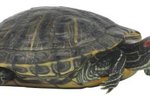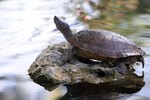
The mellow Central American wood turtle (Rhinoclemmys pulcherrima manni) is a relatively low-maintenance exotic pet option. The pet turtles, which are prevalent in regions of Costa Rica, Nicaragua and southern Mexico, are semi-aquatic animals that typically display rather meek and quiet dispositions. These turtles typically roam throughout scrublands and moist forest.
Central American Wood Turtle Diet
Free-roaming wild Central American wood turtles are herbivorous creatures to the core, consuming mostly only plant matter. However, when necessary, these turtles also occasionally do eat worms and bugs, making them essentially omnivorous. If you have a Central American wood turtle as a pet, commercial rehydrated turtle chow is a strong foundation to the diet, along with occasional fresh veggies and fruit. Some suitable fruits and vegetables for these turtles include apples, peaches, carrots, dandelions, banana, green beans, raspberries, kale, blueberries and mangoes. To add much-needed protein into your turtle's diet, feed him earthworms, mealworms, red worms and crickets, as well. Feed fully mature Central American wood turtles 3 or 4 times a week. Skip one day between feedings. In cases of juvenile wood turtles, however, daily feedings are vital. Regular vitamin and calcium supplementation also is crucial for Central American wood turtles.
Pen
Central American wood turtles generally are very lively creatures, and because of that, they may have more success living in an open pen instead of a classic aquarium tank. Conceal the top with screening. Make sure the pen is semi-aquatic, as these little guys do require a little daily "water time." Keep the swimming spot on the shallow side -- just deep enough to exceed the height of the shell by roughly an inch. Change the water on a regular basis, at least weekly, to avoid bacteria buildup. Potting mix that is damp and devoid of chemicals may make a suitable substrate. Consider blending in a little bit of damp sphagnum moss, as well. Make sure your turtle always has a "safe zone" in his pen -- think a hide box, for example. Away from the swimming area, make sure to place basking rocks with smooth surfaces, as well. Climbing plants in the pen also are useful for hiding purposes. Use a piece of driftwood to establish a sloping "ramp" of sorts to make it easy for your turtle to travel between the water pool and the dry area.
Lighting
Light is a must for any healthy Central American wood turtle living environment. Give your turtle access to UVB rays via fluorescent lighting for approximately half of the day. If your turtle lives outdoors and has access to natural light, extra lighting is unnecessary. In times of inclement weather, however, it is very important to ensure that your outdoor turtle has a secondary living space inside, as well.
Appropriate Temperature
Make sure always to monitor your Central American wood turtle's habitat temperature closely. Always maintain a temperature range of 76 to 86 degrees Fahrenheit. Keep these turtles' pens away from windows that have drafts. High humidity levels, between 75 and 90 percent, are beneficial for these turtles, so it is important to use a mister every day. A hygrometer may be useful for monitoring these levels.
References
- Tortoise Trust: Care & Breeding of the Central American Wood Turtle
- Extraordinary Ecotherms: Wood Turtle Care Sheet
- Diane's Zoo: Central American Wood Turtles
- Reptile Channel: Captive Care and Breeding of the Central American Ornate Wood Turtle
- Austins Turtle Page: Central American Ornate Wood Turtle
- Animal World: Ornate Wood Turtle
- Knoxville Zoo: Central American Wood Turtle
Photo Credits
-
Zedcor Wholly Owned/PhotoObjects.net/Getty Images




